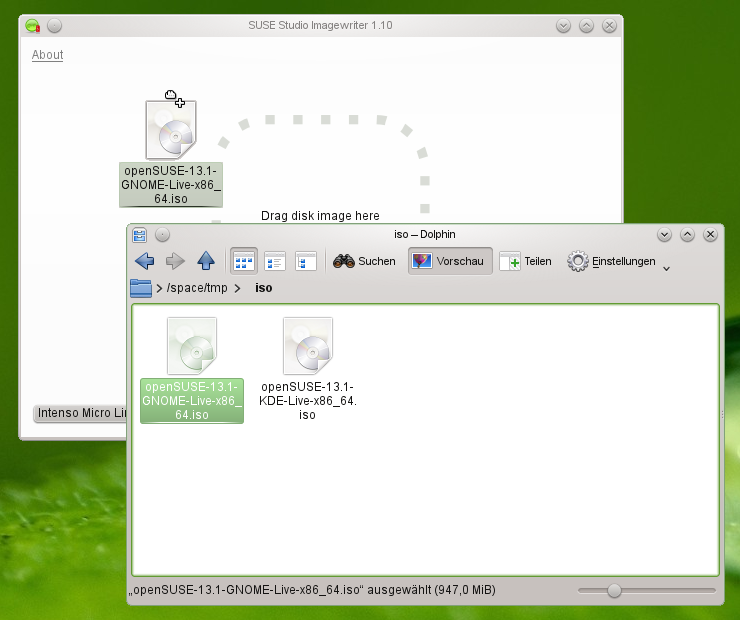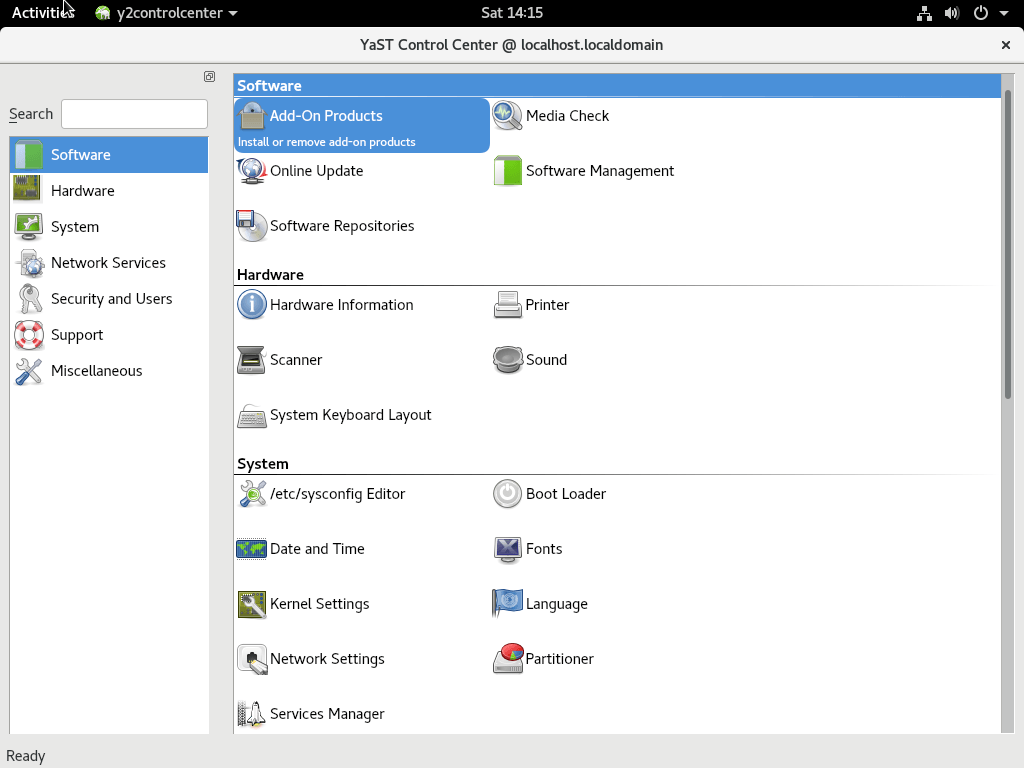Before installingthe SUSE Linux guest, note the following:
You must install the tog-pegasus RPM kit prior toinstalling the SUSE Linux RPM guest kit; however, the SUSE Linux installationmedia does not contain the tog-pegasus RPM kit. This RPM kit is availablein the “HP Integrity Essentials Foundation Pack for Linux”(also known as HPIEFL for Linux).
The SUSE Linux RPMguest kit is actually two parts, a guest kit and a provider kit. TheHpvm.*.rpm kit contains:
The Hpvmprovider.*.rpm kit contains the VMproviderand related files. This RPM requires that both the hpvm and tog-pegasuskits must be installed.
The information you need is provided in Chapter 5 of the HP Integrity Essentials Foundation Pack for Linux User's Guide.
To download the HPIEFL for Linux kit, click the link http://www.hp.com/go/integritylinuxessentials listed in Chapter 5, then click Download for HP IntegrityEssentials Foundation Pack for Linux link on this website.
The first time you install the Linux guest managementsoftware, the following error may occur:
from /var/log/messages file Jan 18 22:45:00 1sn000 kernel: ipmi_si: Error clearing flags: cl from 'dmesg' command ipmi_si: Error clearing flags: clYou can ignorethis error message.
SLES 10 requires the media to be in the first opticaldrive present to the guest; otherwise, the installation fails withthe following error:
Failed to initialize the catalog. Try again?

The name of the ISO is SLES-10-SP4-DVD-i386-GM-DVD1.iso for the i386 version,or SLES-10-SP4-DVD-x8664-GM-DVD1.iso for the x8664 version. Here are a couple of download linksthat I found using Google: Download Suse Enterprise Linux 11. SUSE Linux Enterprise Server (SLES 10) Installation and Administration Guide Table of Contents I Deployment.
The following steps install SUSE Linux EnterpriseServer (SLES) for HP Integrity servers SLES 10 update 1 guests:
Sles 10 Iso Download



Opensuse 10 Iso
On the VM Host system,load the *.iso files of SUSE Linux Enterprise Server (SLES) for HPIntegrity servers SLES 10 update 1 into the following directory:
/var/opt/hpvm/ISO-images/linux/Use the following file names or any file namesyou prefer:
SLES-U1-ia64-AS-disc2.iso
For security reasons, mark the ISO images as read-only.
Create a virtual machinewith one disk and one DVD device for the ISO files, as well as onenetwork virtual switch. Specify the operating system type as LINUX.For example:
#hpvmcreate -P linux -B manual -O LINUX -c 1 -r 2G -a disk:scsi::lv:/dev/vg01/sles10_boot_volume -a disk:scsi::file:/var/opt/hpvm/ISO-images/linux/SLES10-SP1-DVD-ia64-DVD1.iso -a network:lan::vswitch:switch1If DVD2 is required during your installation, eject(EJ) DVD1 and insert (IN) DVD2 from the guest management console.
On the VM Host system,start the virtual machine:
#hpvmstart -P linux1(C) Copyright 2000 - 2008 Hewlett-Packard Development Company, L.P.Opening minor device and creating guest machine containerCreation of VM, minor device 1Allocating guest memory: 2048MB allocating low RAM (0-80000000, 2048MB)/opt/hpvm/lbin/hpvmapp (/var/opt/hpvm/uuids/eaccd6e4-b004-11db-bd1f-00306ef4693e/vmm_config.next): Allocated 2147483648 bytes at 0x6000000100000000 allocating firmware RAM (ffaa0000-ffab5000, 84KB)/opt/hpvm/lbin/hpvmapp (/var/opt/hpvm/uuids/eaccd6e4-b004-11db-bd1f-00306ef4693e/vmm_config.next): Allocated 86016 bytes at 0x6000000180000000Loading boot imageImage initial IP=102000 GP=62E000Initialize guest memory mapping tablesStarting event polling threadStarting thread initializationDaemonizing....hpvmstart: Successful start initiation of guest 'linux1'Use the hpvmconsole command to connect to the guest.
Boot the guest.
Boot the guest in one of the following ways:
To boot from the EFI shell:
Go to the EFI shell. Forexample:
fs0 : Acpi(PNP0A03,0)/Pci(0|0)/Scsi(Pun0,Lun0)/HD(Part1,Sig5D1D1134-C809-11DB-9AEB-000000000000)fs1 : Acpi(PNP0A03,0)/Pci(0|0)/Scsi(Pun0,Lun0)/HD(Part2,Sig5DB58D88-C809-11DB-9AEB-000000000000)fs2 : Acpi(PNP0A03,0)/Pci(0|0)/Scsi(Pun1,Lun0)/CDROM(Entry0)EFI lists devices with file systemsdetected as fs{n}. In this example, fs0 and fs1 are older file systems that are presenton the disk. fs2 is the file system correspondingto the bootable Linux ISO image/Virtual DVD, as can be recognizedby the CDROM against it.
Boot the first installationDVD, which is indicated in the device mapping table by /CDROM by entering the following commands:
shell > fsn:fsn > bootia64Where n corresponds to the Virtual DVD.
The following example shows how to boot from fs0:
# hpvmconsole -P linux1- - - - - - - - - - Prior Console Output - - - - - - - - - -Device mapping table fs0 : Acpi(PNP0A03,0)/Pci(0|0)/Scsi(Pun1,Lun0)/CDROM(Entry0) blk0 : Acpi(PNP0A03,0)/Pci(0|0)/Scsi(Pun0,Lun0) blk1 : Acpi(PNP0A03,0)/Pci(0|0)/Scsi(Pun1,Lun0) blk2 : Acpi(PNP0A03,0)/Pci(0|0)/Scsi(Pun1,Lun0)/CDROM(Entry0) blk3 : Acpi(PNP0A03,0)/Pci(0|0)/Scsi(Pun2,Lun0) blk4 : Acpi(PNP0A03,0)/Pci(0|0)/Scsi(Pun3,Lun0) blk5 : Acpi(PNP0A03,0)/Pci(0|0)/Scsi(Pun4,Lun0) blk6 : Acpi(PNP0A03,0)/Pci(0|0)/Scsi(Pun5,Lun0)Shell> fs0:fs0:>bootia64To boot from the File menu:
Exit the EFI shell.
Select Boot from a file.
Select Removable Media Boot, then press Enter.
The guest bootsfrom the media.
When the screen labeledSUSE Linux Itanium Edition appears, enter the following:
console=ttyS0 command in the Boot:box:
Boot: console=ttyS0NOTE: Failure to add this option results in an apparentguest hang, where the guest is trying to run a graphical installationprogram without a display. If this happens, reset the virtual machine.Press Ctrl/B to reach the virtual console. Enterthe RS command to restart the virtual machine. Resume the installation procedure. The installation process continues:
On the CD Found screen, select Skip.
The boot program presentsa sequence of screens that allow you to customize Linux. Follow normalSUSE SLES10 install procedures.
NOTE: If you use ISO images for installation, you canleave the virtual CD images mounted, so that you can easily installadditional software at a later time. Optionally, remove thevirtual DVD device from the guest using the hpvmmodify command. For example, enter this command on the VM Host:
# hpvmmodify -P guest1 -d dvd:scsi::file:/var/opt/hpvm/ISO-images/linux/SLES-U1-ia64-AS-disc1.iso dvd:scsi::file:/var/opt/hpvm/ISO-images/linux/SLES-U1-ia64-AS-disc2.iso
